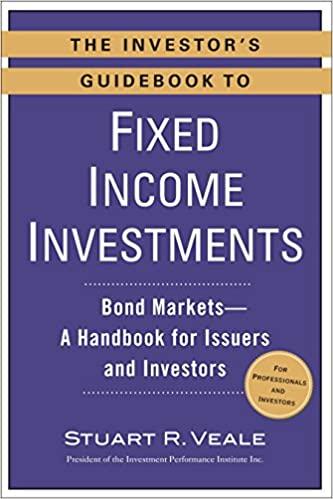Question
ALL OF THEM NEED TO BE ANSWERED Current underlying price at 100. Mean absolute deviation of 20. Q2a. What is the price of an ATM
ALL OF THEM NEED TO BE ANSWERED
Current underlying price at 100. Mean absolute deviation of 20.
Q2a. What is the price of an ATM PUT and ATM CALL? What is the delta value of 2 long CALLs?
Q2c. What is the gamma value of your the ATM CALL position, hedged with underlying shares from Q2b?
Q2d. Based on the delta and gamma values above, What is the delta of the above straddle when underlying moves to $120? What is your position PnL?
Q2e. Based on the delta and gamma values above, what is the delta of the above straddle when underlying moves to $80? What is your position PnL?
Q2f. Use the quadratic analytical option pricing formula under uniform distribution to calculate CALL price at $120 and $80. Compare the exact PnL calculated with the quadratic formula with the PnL based on delta and gamma approximation from Q2d and Q2e.
(for practice, redo the question with 2 long PUT contracts)
Q3. A binary PUT option will pay $1 if price of underlying at expiration falls below strike price K, and zero otherwise. A binary CALL option will pay $1 if price of underlying expires ABOVE strike price K and zero other wise.
A binary PUT will be priced at the CDF value at strike K. A binary CALL is worth 1 - CDF(K).
Underlying price at $100. Option has 1 year to go b/f expiration.
Q3a. If you observed $80 PUT is priced at 16 cents. What is the implied volatility in dollar term b/w now and expiration?
Note: implied volatility is the the standard deviation parameter that is consistent with the option price.
Q3b. If you observed $110 CALL is priced at 16 cents. What is the implied volatility in dollar term b/w now and expiration?
Q4. Underlying at $100 and standard deviation at $10.
PUT option has strike of $95.
Q4a. What is the probability for PUT to be in the money?
Q4b. What is the average price of the underlying conditional on PUT expiring ITM?
Q4c. Based on Q4a and Q4b, how much should the 95 PUT be priced at?
Q5. Underlying at $100 and standard deviation at $10.
CALL option has strike of $95.
Q5a. What is the probability for CALL to be in the money at expiration?
Q5b. What is the average price of the underlying conditional on CALL expiring ITM?
Q5c. Based on Q5a and Q5b, how much should the 95 CALL be priced at?
Step by Step Solution
There are 3 Steps involved in it
Step: 1

Get Instant Access to Expert-Tailored Solutions
See step-by-step solutions with expert insights and AI powered tools for academic success
Step: 2

Step: 3

Ace Your Homework with AI
Get the answers you need in no time with our AI-driven, step-by-step assistance
Get Started


